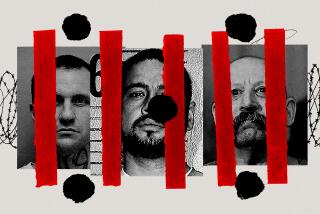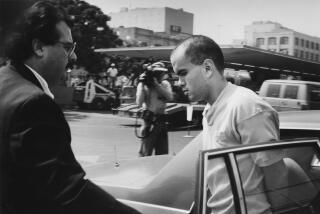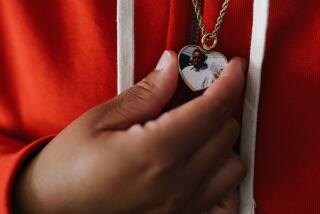Writings by Markhasev Show Guilt, Court Told
The murder trial of the Ukrainian immigrant accused of killing entertainer Bill Cosbyâs son turned into a real whodunit Monday after a day of hard-hitting opening statements and the revelation of damning jailhouse correspondence allegedly written by the defendant.
The prosecution said it will show that Mikhail Markhasev virtually admitted killing Ennis Cosby, 27, in letters and in comments to friends shortly after the shooting.
Deputy Alternate Public Defender Henry Hall struck back, saying he will show strong evidence that Markhasev wasnât at the crime scene, and that key prosecution witness Eli Zakaria killed Cosby but is blaming Markhasev to curry favor with the prosecution in a host of unrelated criminal charges against him.
He argued that Zakaria closely fits the height, weight and other physical characteristics of the killer that were provided by Cosbyâs companion on the night of the shooting. Saying that Zakaria fits the composite sketch based on that description more closely than Markhasev does, Hall displayed before the jury Zacariaâs picture next to the composite.
But by the end of testimony Monday, Deputy Dist. Atty. Anne Ingalls had clearly won the day with the jailhouse letters. For most of the afternoon, Hall and Harriet Hawkins were still struggling to shake a handwriting expertâs testimony that Markhasev was definitely the author of the letters.
In one of them, Markhasev, 19, wrote: âI went to rob a connection, but obviously found something else.â
In another, Markhasev seems to bemoan his predicament: âThey got a lot on me, the quete [Spanish for âgunâ], a beanie, other witnesses. . . .â
And in a third, he talks about a person who âhelped me after the jale [Spanish for âjobâ] get rid of everything.â
And in yet another, he says he made a mistake by involving an Asian friend in helping him after the shooting.
Most of the letters are written to someone simply identified as Huero, and signed Pee Wee, which the prosecution argues is Markhasevâs street name.
The killing happened Jan. 16, 1997, as Ennis Cosby was changing a flat tire while en route to visit a friend, Stephanie Crane of Sherman Oaks. He pulled onto the shoulder of Skirball Center Drive off the San Diego Freeway about 450 feet from a bank of telephones at a park-and-ride lot.
The prosecution argues that Markhasev and two companions--Zakaria and Sara Ann Peters--had just left the nearby home of a friend on Mulholland Drive, where they had been using drugs, and were using the phones to call the friend. While there, Markhasev decided to rob Cosby, prosecutors say.
In her opening statements, Ingalls provided dramatic new details about the killing scene.
When Cosby pulled off the road to change the tire, he was only 10 minutes from Craneâs home. He called her to come help by shining her car lights so he could see better.
At that point, Zakaria, Markhasev and Peters pulled up near him and asked if he was OK.
âYeah, everythingâs cool,â Cosby replied.
Shortly afterward, Crane arrived. As she sat in the car with the engine running and watching Cosby work, Markhasev suddenly appeared at her window and ordered her out of the car, Ingalls said.
âOpen the door or Iâll shoot,â Ingalls quoted Markhasev as saying.
Instead, Crane pulled away, only to turn around after driving a few dozen feet just in time to see Markhasev fleeing toward a waiting car.
After the three discarded the gun, Ingalls said, they appeared at the home of a friend, Itzhak Ben-Senyar in Studio City. He said they were âgluedâ to the television watching news about Cosbyâs death.
Ingalls said that several days later, Markhasev asked Michael Chang, a Huntington Beach resident whom he had known while in the Juvenile Detention Center, to help him find a gun. Christopher So, a friend of Chang, drove them to a wooded area in the San Fernando Valley to look for it.
Ingalls said after an unsuccessful search, So and Chang heard Markhasev say, âI killed a n-----. Itâs all over the news.â
Chang was shocked, Ingalls said.
âYou killed Cosby!â he yelled.
So later tipped off the National Enquirer to earn a $100,000 reward and took police to the search area, where the gun--a .38-caliber semiautomatic pistol--was found and later matched to the bullet that killed Cosby.
Among the first prosecution witnesses was Karen Chiarodit, a handwriting expert with the Los Angeles Police Department. Chiarodit said she compared the jailhouse letters with one Markhasev wrote to a friend and with letters she requested him to write. She said that although there were differences, they were normal variations that are seen in all handwriting.
But overall, characteristics of individual letters in the correspondences were similar.
Det. John Garcia said some of the letters came from a search of garbage at the home of the wife of jailhouse informant David Gomez. And Sheriffâs Deputy Elwood Crane, a jailer, testified that he got some of them from Markhasev by offering to mail them for him. Instead of mailing them, he turned them over to his supervisor, who gave them to investigators. Still others are photocopies provided by Gomez.
In its opening statements, the defense unveiled plans to discredit the prosecutionâs testimony and the validity of the jailhouse letters.
Hall noted that all key prosecution witnesses have huge stakes in blaming Markhasev because they have long criminal histories and many charges pending against them.
He said Gomez, who provided some of the jailhouse letters, is a federal inmate facing charges ranging from rape and robbery to forgery.
He said the letters contain numerous factual errors about the crime that would not have been made by someone who had been there, and that the handwriting was different from Markhasevâs.
The defense will resume its efforts today, but by the end of Monday it had failed to seriously discredit the letters.
Hawkins argued that the jailhouse letters werenât Markhasevâs because one of the letters known to be his was written in all capital letters, while the other jailhouse correspondence had a mixture of capital and lower case letters.
More to Read
Sign up for Essential California
The most important California stories and recommendations in your inbox every morning.
You may occasionally receive promotional content from the Los Angeles Times.










